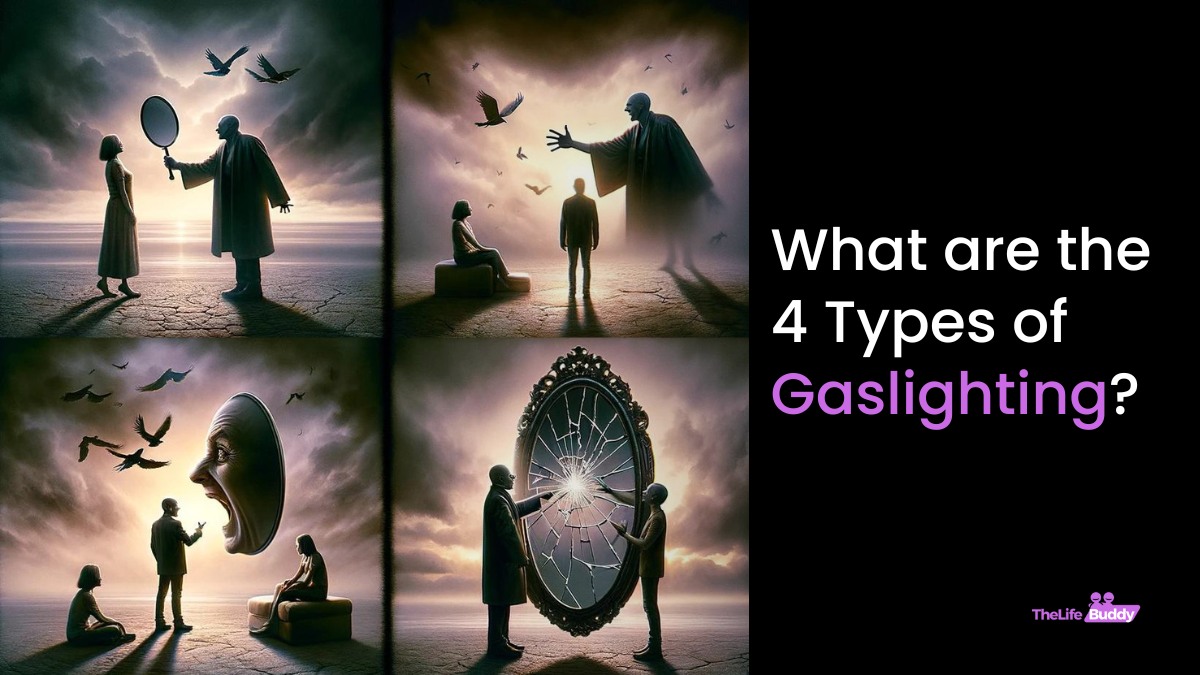What are the 4 Types of Gaslighting? And How to Deal With Them?

Gaslighting is a psychological manipulation technique often used in romantic relationships. It involves making someone doubt their own experiences, memories, and perceptions. The term originated from the 1944 film “Gaslight,” where the protagonist, Paula, is emotionally manipulated by her husband, Gregory. He orchestrates disappearing pictures, mysterious noises, and flickering gaslights, all while denying their existence and insisting Paula is imagining things.
There are mainly four types of gaslighting. Each type of gaslighting, with its unique characteristics, not only challenges one's sense of reality but also deeply impacts emotional well-being. Let's explore these types further, highlighting the emotional nuances and the profound effects they can have on individuals.
1. Blatant Lies
Imagine someone you trust telling you something you know isn't true, yet they do it with such conviction that you start to question your own judgment. This isn't just confusion; it's a deliberate act to unsettle you. The emotional toll here is significant—it undermines your confidence and instills a sense of instability. You may feel isolated, as if the ground beneath you has shifted, leaving you unsure of what or whom to believe. This tactic is jarring, creating a foundational crack in your trust, not just in the gaslighter but potentially in your own judgment. What you can do to deal with it?
Recognize and Affirm Your Truth: When faced with blatant lies, it’s important to trust your intuition and affirm to yourself what you know to be true. Don't argue with the gaslighter; instead, affirm your reality to yourself or to someone you trust.
Document Everything: Keeping a record of events, conversations, and any proof of the truth can help you stay grounded in your reality. This can be particularly helpful when your memory is challenged or when you start to doubt yourself.
2. Questioning Your Memory
This form of gaslighting is insidiously cruel. It's as if someone is editing your reality, telling you events didn't happen when your heart and mind scream otherwise. The emotional impact here is profound. You may begin to distrust your memory, which is akin to losing pieces of your identity. It can lead to anxiety, depression, and a haunting sense of loneliness, as if you're disconnected from your own story. The manipulation here is so personal, so targeted, that it can feel like a betrayal of the self. There are mainly two things you can focus on to deal with this type of gaslighting.
Trust Your Memory: Start by trusting your memory and experiences. If someone questions an event or conversation, reflect on your documented facts and trust in your recollection.
Seek Validation: Talk to others who were present or are aware of the situation. External validation can be powerful in reaffirming your memory and experiences, providing a buffer against the gaslighter’s attempts to make you doubt yourself.
3. Using What You Love Against You
When a gaslighter uses your passions, achievements, or loved ones as ammunition, it's particularly devastating. This attack on your core values and relationships is designed to weaken your sense of self. The emotional aftermath of this can be a mix of anger, grief, and confusion. It's as if the very things that give your life meaning and joy are being turned into sources of pain. This tactic can leave you feeling trapped, as though you're being forced to choose between your sanity and what you hold dear. Here is what you should do next if you are a victim of this type of gaslighting.
Strengthen Your Foundation: Focus on strengthening your relationships, hobbies, and passions that the gaslighter may target. This can help buffer your sense of self and identity against their attacks.
Create a Support System: Surround yourself with people who understand and support you, who can remind you of your worth and the truth of your character when it's being called into question by the gaslighter.
4. Trivializing Your Feelings

This type of gaslighting invalidates your emotional experiences, making you feel as though your reactions are overblown or unwarranted. It's a form of emotional dismissal that can make you question the legitimacy of your feelings. This continuous undermining can erode your self-esteem and make you feel small and insignificant. The emotional resonance of being repeatedly told that your feelings don't matter is a deep loneliness and a sense of being misunderstood and unvalued. When someone Trivializing your emotions or feelings and you find yourself gaslighted do these.
Validate Your Feelings: Remember that your feelings are valid, regardless of how the gaslighter tries to trivialize them. Practice self-validation by acknowledging and accepting your emotions as legitimate and important.
Set Emotional Boundaries: It’s crucial to set boundaries around how others are allowed to speak to and treat you. Let the gaslighter know that it’s not acceptable to belittle your feelings, and seek space from the conversation if your emotions are not being respected.
Before You Leave...
In all instances, self-care is paramount. Taking care of your mental, emotional, and physical well-being can provide the strength needed to navigate through gaslighting. This might include engaging in activities that make you feel good, practicing mindfulness or meditation, and seeking professional help if the situation becomes overwhelming.
Dealing with gaslighting is undoubtedly challenging, but remember, you possess inner strength and resilience. With the right tools and support, you can navigate through this and emerge even stronger on the other side.



One thought on “What are the 4 Types of Gaslighting? And How to Deal With Them?”
Comments are closed.